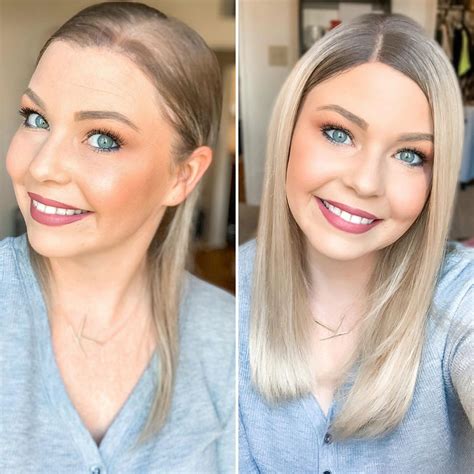A Revolutionary Solution to Achieve a Fuller, More Voluminous Hair
Hair loss is a common concern affecting millions worldwide, with over 50% of women experiencing some degree of hair thinning by the age of 50. Hair toppers offer a discreet and effective solution to conceal thinning areas and restore confidence in one’s appearance.

What is a Hair Topper?
A hair topper, also known as a hairpiece or wiglet, is a small to medium-sized hairpiece designed to fit seamlessly over thinning or balding areas on the scalp. It typically features a base made of synthetic or human hair and attaches securely using clips or combs.
Benefits of Hair Toppers
- Instant and Dramatic Volume: Hair toppers instantly add fullness and volume to thinning hair, creating a thicker, lusher look.
- Conceals Thinning Areas: Toppers effectively cover up sparse or bald patches, making hair appear thicker and healthier.
- Improves Confidence and Self-Esteem: Regaining a fuller head of hair can significantly boost confidence and self-image.
- Versatile and Flexible: Hair toppers can be styled, washed, and blow-dried just like natural hair, allowing for a wide range of looks.
- Non-Surgical Option: Toppers provide a non-invasive and affordable alternative to surgical hair restoration procedures.
Types of Hair Toppers
- Synthetic Hair Toppers: Made from artificial fibers, these toppers are more affordable and easier to maintain but may not be as natural-looking.
- Human Hair Toppers: Crafted from real human hair, these toppers offer a more natural texture and appearance, but they are more expensive.
- Custom Made Toppers: Designed specifically to fit your head shape and hair color, custom-made toppers provide the most realistic and seamless result.
How to Choose the Right Hair Topper
- Size: Determine the area you want to conceal and choose a topper that fits comfortably over it.
- Hair Color: Match the topper’s shade as closely as possible to your natural hair color.
- Texture: Consider your hair type and select a topper with a similar texture for a natural blend.
- Base Type: Choose a base that is comfortable, breathable, and easy to attach.
- Brand and Reputation: Research reputable brands and read reviews to ensure you’re getting a high-quality topper.
Common Mistakes to Avoid
- Choosing the Wrong Size: A poorly fitting topper can look unnatural or become uncomfortable to wear.
- Mismatched Color: An incorrect color choice can make the topper stand out and look obvious.
- Over-Styling: Excessive styling can damage the topper and shorten its lifespan.
- Neglecting Maintenance: Regular cleaning and conditioning are crucial to keep your topper looking its best.
- Ignoring Professional Advice: Consulting with a hair stylist or salon can provide valuable insights and ensure proper fit and styling.
Why Hair Toppers Matter
- Empowerment: Hair toppers empower individuals to express themselves and regain their confidence amidst hair loss.
- Mental Health: Feeling good about one’s appearance can positively impact mental health and overall well-being.
- Social Acceptance: Hair loss can lead to stigma and discrimination, and toppers help individuals feel more accepted and included.
- Disease Management: Some medical conditions, such as alopecia or cancer treatment, cause hair loss. Toppers offer a way to cope with these challenges.
- Self-Care: Investing in a hair topper is a form of self-care that prioritizes one’s appearance and emotional well-being.
Conclusion
Hair toppers are a revolutionary solution for individuals experiencing hair loss. They offer instant volume, conceal thinning areas, and boost confidence. By understanding the benefits, types, and best practices associated with hair toppers, you can make an informed decision that will restore your hair’s fullness and empower you to live a more fulfilling life.
Tables
Table 1: Hair Topper Types and Features
| Type | Material | Appearance | Maintenance | Cost |
|---|---|---|---|---|
| Synthetic | Artificial fibers | Less natural-looking | Minimal | Affordable |
| Human Hair | Real human hair | Natural texture and appearance | Extensive | Expensive |
| Custom Made | Designed for your head shape and hair color | Most seamless and realistic | Requires professional fitting | Most expensive |
Table 2: Common Hair Loss Conditions and Their Prevalence
| Condition | Prevalence | Causes |
|---|---|---|
| Androgenetic Alopecia (male-pattern baldness) | 50% in men over 50 | Genetics |
| Female-Pattern Hair Loss | 50% in women over 50 | Genetics, hormones |
| Alopecia Areata | 0.2% of the population | Autoimmune disorder |
| Chemotherapy-Induced Hair Loss | 95% of cancer patients undergoing chemotherapy | Side effect of treatment |
Table 3: Benefits of Hair Toppers
| Benefit | Impact |
|---|---|
| Instant Volume | Increased confidence and self-esteem |
| Concealed Thinning Areas | Improved appearance and reduced stigma |
| Non-Surgical Option | Affordable and less invasive than surgical procedures |
| Versatile and Flexible | Multiple styling options for a wide range of looks |
| Empowerment | Promotes self-acceptance and well-being |
Table 4: Pain Points of Hair Loss
| Pain Point | Impact |
|---|---|
| Reduced Confidence | Difficulty in social situations and feeling self-conscious |
| Social Stigma | Discrimination and negative stereotypes associated with hair loss |
| Emotional Distress | Depression, anxiety, and diminished self-worth |
| Increased Vulnerability | Heightened risk of cyberbullying or harassment |
| Impact on Physical Health | Can lead to sunburns and scalp irritation |
